Tools - Classical antiquity - Available - Photo gallery
Image database with photographs of ancient art and antiquities
Our image database provides photographs of ancient art and antiquities for press releases as well as for private use. All artefacts sold in our gallery are documented through professional photographs. The resulting image library contains numerous ancient Egyptian, Greek and Roman antiquities as well as ancient coins. The time span from Stone Age, over Bronze Age and Classical Antiquity until Late Antiquity is covered.The photo gallery aims at providing a vast visual archive equipped with filters and search tools. You are most welcome to search the constantly growing number of artefacts in the image library. We are also happy to authorize hyperlinks from your webpage / forum to the objects depicted in our gallery. For this purpose, please send us a short notification prior to placing a hyperlink. For almost every object high definition photographs are available and can be provided e.g. to document your collection or for scientific papers or popular science articles. If you are interested in using pictures for publications, print media or other purposes, please contact us and we will be happy to assist you.
-
 Bronze Age Axehead Hoard
Bronze Age Axehead HoardOriginal group dating to the Middle Bronze Age of Northern Europe. It was buried around 3400 years ago south of Chiddingford in Great Britain.
 Buy Bronze age palstave axehead
Buy Bronze age palstave axeheadNicely decorated piece from a Bronze Age hoard found in Manston, UK. 1400 to 1150 BC.
 Buy Bronze age palstave axehead
Buy Bronze age palstave axeheadExtremely well preserved piece from a Bronze Age hoard found in Manston, UK. 1400 to 1150 BC.
 Palstave axehead with decoration
Palstave axehead with decorationExtremely well preserved piece from a Bronze Age hoard found in Manston, UK. 1400 to 1150 BC.
 Etruscan bronze ladle - ex Sotheby's
Etruscan bronze ladle - ex Sotheby'sVery good condition, undamaged, with thick patina. Late Etruscan, 4th - 3rd century BC. From an old English collection.
 Byzantine bronze processional cross holder
Byzantine bronze processional cross holderExcellent condition, beautiful patina, worth the exhibition in a museum. Middle Byzantine Period, Constantinople or Asia Minor workshop.
 Mosaic glass inlays and spindle whorls
Mosaic glass inlays and spindle whorlsNice group of polychrome inlays and spindle weights from Roman Egypt. Including two fragments with a wonderful floral decor.
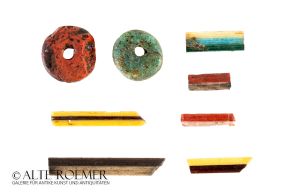 Roman-Egyptian glass inlays and spindle whorls
Roman-Egyptian glass inlays and spindle whorlsNice group of polychrome inlays and spindle weights from Roman Egypt. From an old English collection, ex Bonhams London.
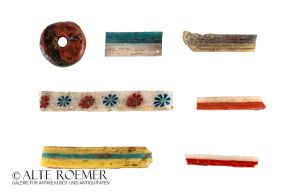 Mosaic glass inlays and spindle whorl
Mosaic glass inlays and spindle whorlNice group of polychrome inlays and a spindle weight from Roman Egypt. Including one fragment with a wonderful floral decor.
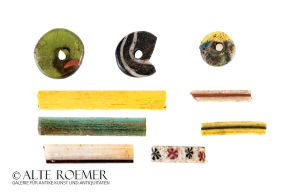 Mosaic glass inlays and spindle whorls
Mosaic glass inlays and spindle whorlsNice group of polychrome inlays and spindle weights from Roman Egypt. Including one fragment with a wonderful floral decor.
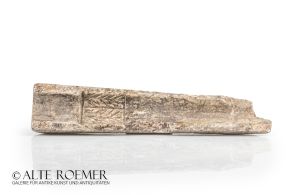 Bronze Age casting mould for a chisel
Bronze Age casting mould for a chiselOne half of a stone mould for bronze casting. The equipment is from a workshop of the 2nd Millennium BC, probably from the Carpathian Basin. From the famous Guttmann Collection. This mould was published in a work by Born and Hansen.
 Bronze Age casting mould for a lance head
Bronze Age casting mould for a lance headOne half of a stone mould for bronze casting. The equipment is from a workshop of the 2nd Millennium BC, probably from the Carpathian Basin. From the famous Guttmann Collection. This mould was published in a work by Born and Hansen.
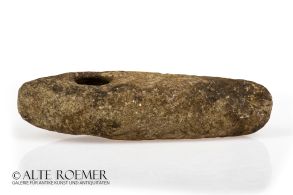 Neolithic axe head
Neolithic axe headThe strong blade was probably used for a battle axe. Crafted from grey rock. An artefact from the Neolithic Age of Europe.
 Mosaic glass inlays and spindle whorls
Mosaic glass inlays and spindle whorlsNice group of polychrome inlays and spindle weights from Roman Egypt. Including two fragments with a wonderful floral decor.


 Neolithic sickle from Denmark
Neolithic sickle from DenmarkCrescent-shaped blade made of beautiful brown flint. This tool represents an intermediate state within the radical transition from Neolithic to Bronze Age.
 Neolithic axe head
Neolithic axe headNicely crafted tool made of beige stone. From the New Stone Age of Europe. A specimen of the thick butted type with thin blade.

 Neolithic dagger blade from Denmark
Neolithic dagger blade from DenmarkDouble-edged, pointed blade made of beautiful flint. The blade was for a dagger, the typical status symbol from the transitional period between Late Neolithic and Early Bronze Age.
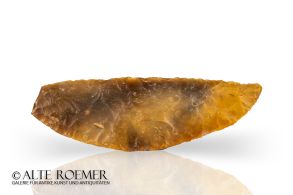 Neolithic flint sickle from Denmark
Neolithic flint sickle from DenmarkCrescent-shaped blade made of beautiful brown flintstone. This tool represents an intermediate state within the radical transition from Neolithic to Bronze Age.
 Luristan hatchet with eyes
Luristan hatchet with eyesAxe head originating from the Luristan region during Iron Age. The piece is decorated with eyes to form a stylized bird's head.
 Luristan axe head
Luristan axe headBronze axe originating from the Luristan region during Bronze Age. From the Sasson family collection.

 Neolithic flint dagger from Denmark
Neolithic flint dagger from DenmarkDouble-edged blade and flat shaft made of beautiful flintstone. A status symbol from the transitional period between Late Neolithic and Early Bronze Age.
 Luristan battle axe with eyes
Luristan battle axe with eyesAxe head originating from the Luristan region during Early Bronze Age. The piece is decorated with eyes to form a stylized bird's head.
 Luristan bronze axe
Luristan bronze axeNicely decorated axe head originating from the Luristan region. From the Sasson family collection.
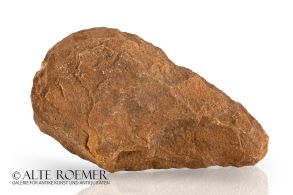 Paleolithic hand axe
Paleolithic hand axePrehistoric stone tool. It was the universal tool of the older Stone age and could be used as a borer or a cutter. From a Swiss museum collection. Found in Algeria, North Africa.
 Neolithic flint dagger from Denmark
Neolithic flint dagger from DenmarkDouble-edged blade and flat shaft made of beautiful flintstone. A status symbol from the transitional period between Late Neolithic and Early Bronze Age.
 Neolithic dagger blade from Denmark
Neolithic dagger blade from DenmarkDouble-edged, pointed blade made of beautiful flint. The blade was for a dagger, the typical status symbol from the transitional period between Late Neolithic and Early Bronze Age.
 Neolithic flint sickle from Denmark
Neolithic flint sickle from DenmarkCrescent-shaped blade made of beautiful reddish-brown flintstone. This tool represents an intermediate state within the radical transition from Neolithic to Bronze Age.



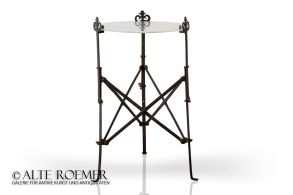 Published Roman bronze folding tripod
Published Roman bronze folding tripodAbsolutely magnificent condition, the likes of which are rarely found in museums and collections worldwide for Roman bronze furniture. Examined at the RGZM Cologne in the 1980s.
 Egyptian cosmetic palette as a bird
Egyptian cosmetic palette as a birdPalette in the shape of a bird from predynastic Egypt. From the inventory of the Musée d'art et d'histoire in Geneva.

